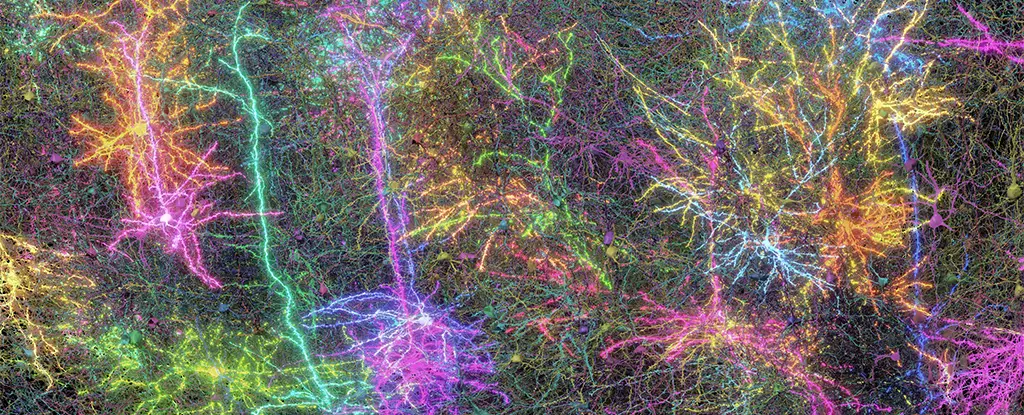The exploration of the human brain is akin to navigating an uncharted galaxy; its intricacies are vast and often unfathomable. Recent groundbreaking research has propelled our understanding of this enigmatic organ further than ever, illustrating the sheer complexity of neural connections that govern our perception, emotions, and decision-making processes. By meticulously mapping a minuscule section of a mouse brain, researchers achieved remarkable insights into the connectivity that defines not only individual neurons but also the collective function of the entire neural network. This monumental effort required nearly a decade, engaging over 150 researchers from leading institutions like Princeton and the Allen Institute, showcasing the collaborative spirit that fuels scientific advancement.
Through the painstaking analysis of a tissue volume no larger than a grain of sand, scientists unveiled a staggering 84,000 neurons interlinked by approximately half a billion synaptic connections. The overwhelming nature of these figures may be disconcerting—for the average individual, wrapping one’s mind around such numbers is daunting. Yet, it is within this complexity that the elegance of brain function resides, marrying structure with behavior in a manner that can reshape our understanding of not just our health, but the essence of what it means to be human.
A New Dawn for Connectomics
The culmination of this research is what scientists refer to as the “connectome”—a comprehensive wiring diagram of the brain. While previous studies have mapped insect brains, this initiative represents an unprecedented leap into the intricate web of mammalian neuroscience. With advanced AI tools complementing traditional methodologies, the research team was able to dissect and analyze the neuronal wiring, creating a detailed visual representation that stands as a testament to human ingenuity.
The implications of this groundbreaking work are vast and multifaceted. One aspect that stands out is the accessibility of this data for future research. By releasing their findings to the public domain, researchers not only encourage continued exploration but foster a culture of openness that is essential for scientific progress. The human brain, in its current evolutionary state, is unmatched by artificial intelligence in both speed and efficiency, and the insights garnered from the connectome can illuminate the path towards understanding why that is.
The Potential for Transformative Insights
With the digital representation of the brain now pioneered, the possibilities for neurological research could be revolutionary. Conditions such as dementia, which profoundly alter lives, may soon be approached with a new lens—recognizing that understanding the brain’s wiring is paramount in deciphering how and why such disorders arise. The researchers posit that identifying irregular patterns of connectivity could yield critical breakthroughs in diagnosis and treatment. No longer will brain diseases be shrouded in mystery; the tools at our disposal may soon tell us why certain pathways falter, which could lead to targeted interventions.
Neuroscience operates at the fascinating intersection of biology and technology, and this project exemplifies the potential for interdisciplinary collaborations to drive discovery. As scholars like H. Sebastian Seung note, we are standing at the cusp of a digital transformation in brain science. The connective tissue of neurons, pulsating with life, must not only be understood through a physical lens, but appreciated for the idiosyncrasies that define our cognitive landscape.
Ethical Dimensions of Neuroscience
While the advancements in neuroscience bring optimism, they are not without ethical complications. As we begin to unlock the secrets of the brain, questions arise concerning privacy and the implications of our newfound knowledge. What responsibilities do we bear as researchers when it comes to the potential misuse of this information? From cognitive enhancement to the policing of mental health, the trends emerging from neuroscience require societal discourse that balances innovation against ethical considerations.
The risks associated with manipulating brain function or using such insight for nefarious purposes pose a particular quandary. As we steer through this nebulous territory, we must ensure that our discoveries are wielded for the greater good, protecting individual privacy while embracing the societal benefits that come from understanding our neural architecture.
The endeavors within neuroscience not only unravel the workings of the brain but also hold a mirror to society’s values and ethics, crafting a future where knowledge and responsibility must align. As we delve deeper into the realms of the mind, the quest for understanding becomes as much about ethics as it is about science, challenging us to thoughtfully navigate the frontier of our neurological cosmos.


Leave a Reply